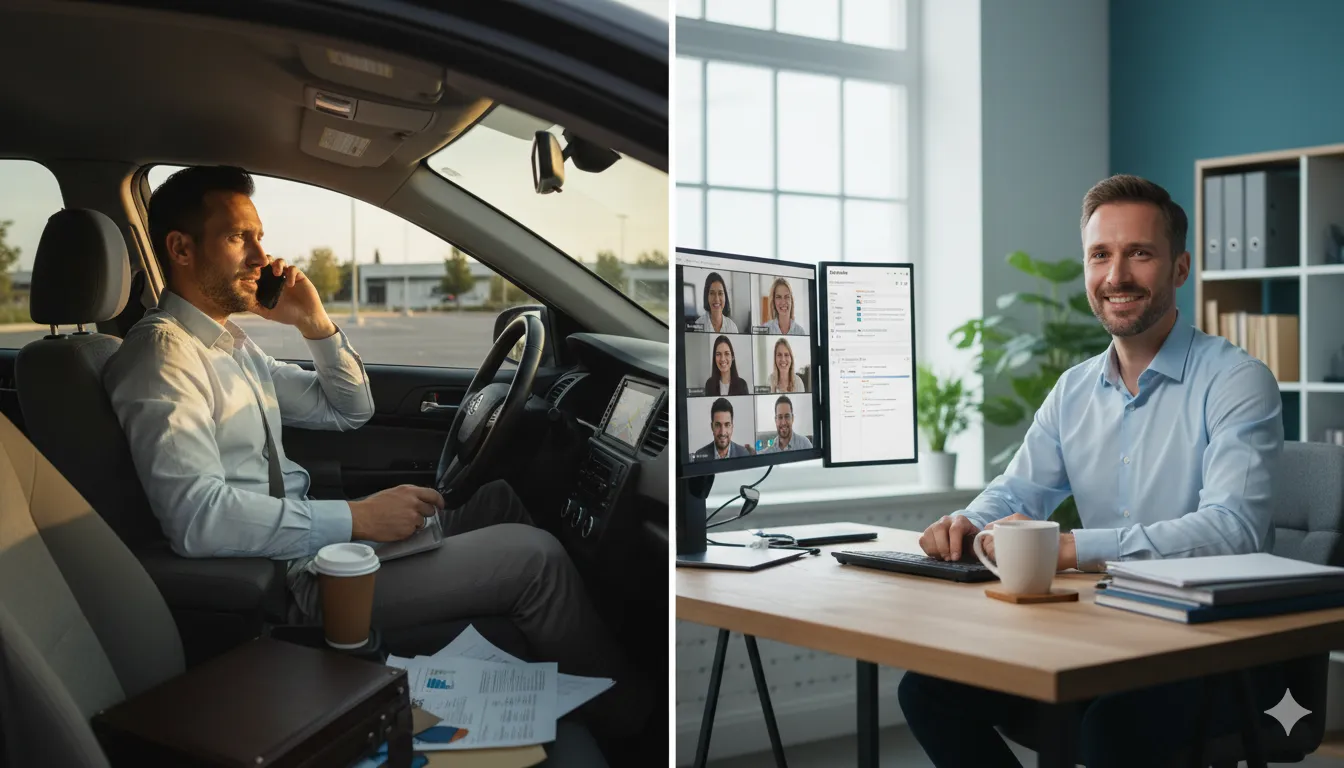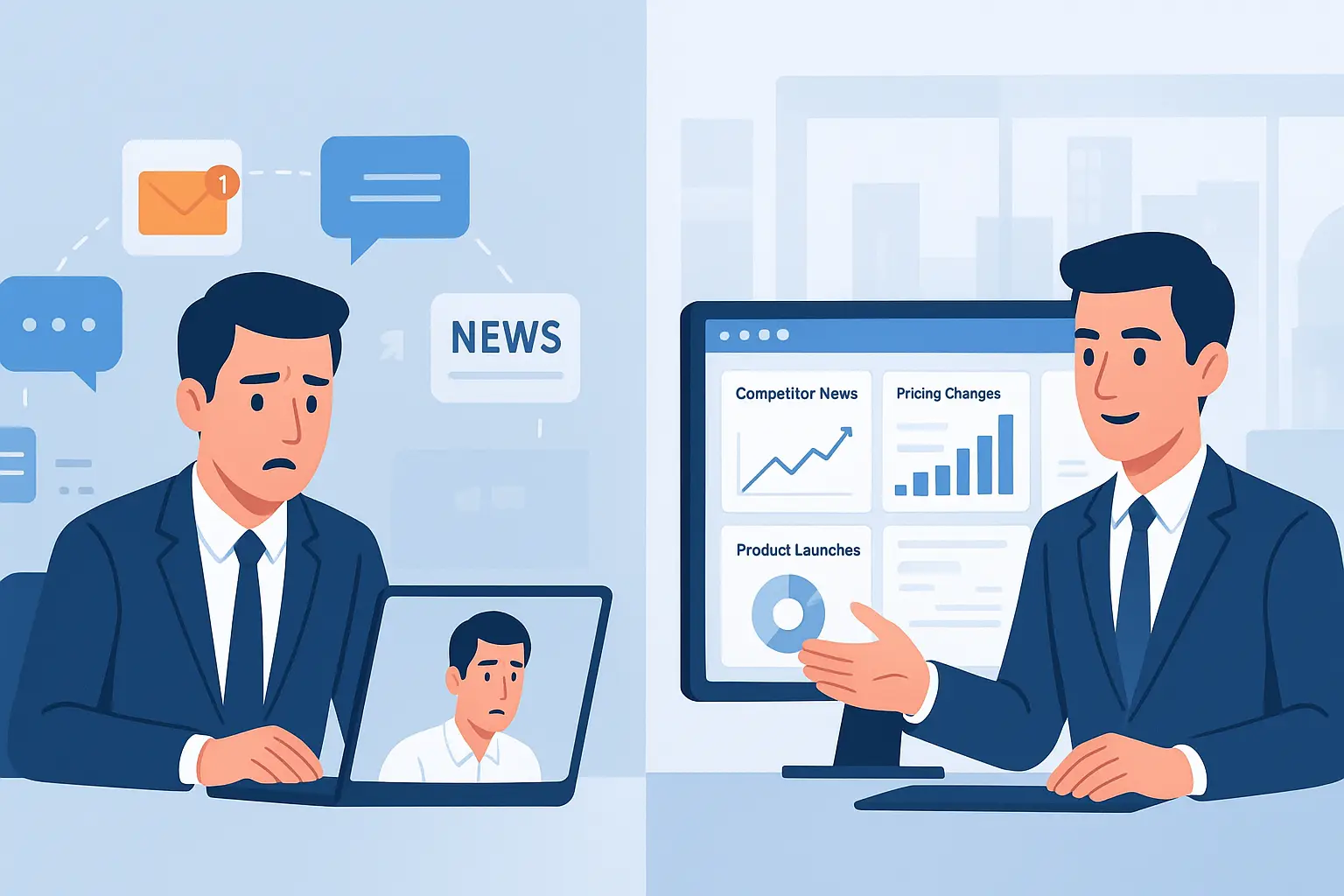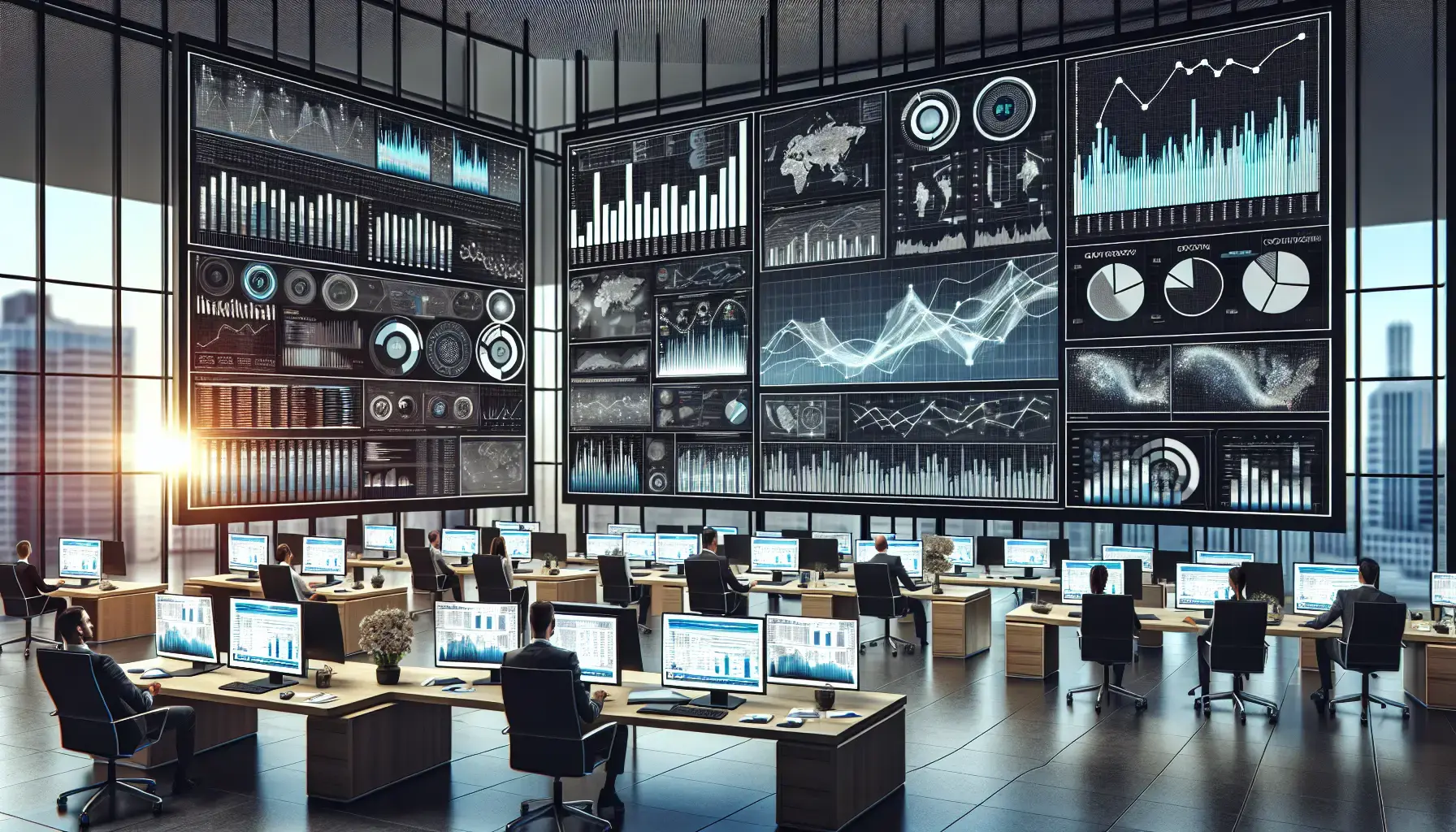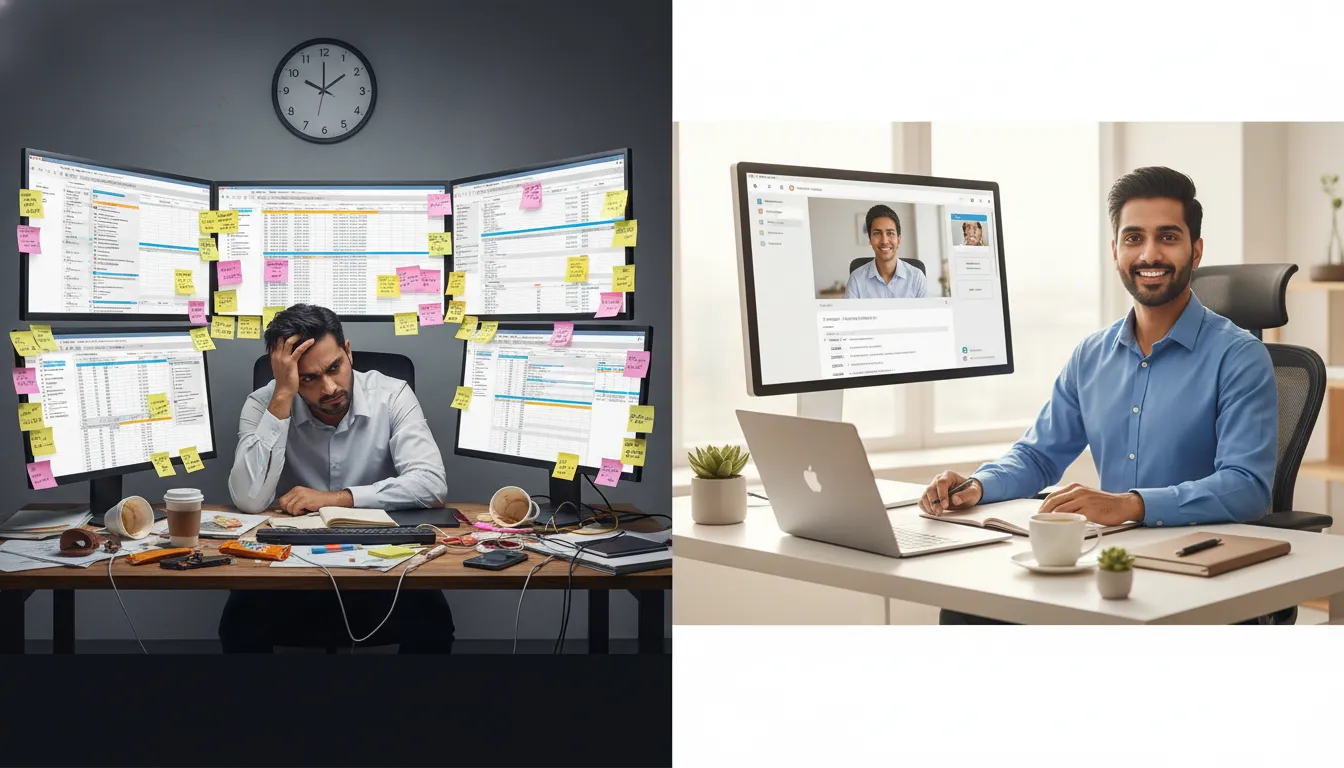Why the Best Sales Happen From Your Couch: The Death of Outside Sales Nobody’s Talking About
There’s a Reddit post that’s been haunting me for the past week.
A sales professional made the “dream” jump from inside to outside sales 10 months ago. Great territory. Beautiful area. Excellent ramp-up numbers.
And they’re miserable.
“I’m driving 100-200 miles some days. Windshield time eats hours of my workday. I can’t stay on top of things. I miss my home office.”
The comments flooded in: “Same boat.” “Felt this.” “Thinking of going back.”
Here’s what nobody’s saying out loud: Outside sales is dying, and pretending it’s still the premium path is costing salespeople their sanity and companies their best talent.
The math that doesn’t make sense anymore
Let’s run the actual numbers on that 100-200 mile daily commute:
Time cost:
- 3-4 hours daily driving (at 50mph average with traffic/parking)
- 15-20 hours weekly in the car
- 60-80 hours monthly NOT selling
Financial cost:
- $0.67 per mile IRS rate (gas, maintenance, depreciation)
- $67-134 per day in vehicle costs
- $1,340-2,680 monthly just to show up
Opportunity cost:
- 4 hours driving = time for 16-20 sales calls
- Or 8-12 product demonstrations
- Or 40-60 qualified lead follow-ups
- Or actual relationship building that closes deals
So you’re spending $2,000+ monthly and losing 70+ selling hours to… what exactly? Shake hands? Show you’re “serious” by being physically present?
The brutal reality: a sales rep driving 150 miles to close a $5,000 deal just spent $100 in vehicle costs, 4 hours of time, and could have closed 3 similar deals remotely in that same timeframe.
That’s not premium sales. That’s inefficiency masquerading as effort.
What actually changed (and it’s not coming back)
COVID accelerated a shift that was already happening. But we’re not talking about temporary remote work trends. We’re talking about fundamental changes in how B2B and high-ticket B2C sales happen.
Buyer behavior evolved:
2019: “Can we schedule an in-person meeting next Tuesday?” 2025: “Can you screen-share the demo now? I have 20 minutes.”
Buyers don’t want to block out 2 hours for a meeting that includes:
- 30 minutes of small talk
- 45 minutes of presentation they could have watched async
- 15 minutes of “let me get back to you”
They want efficient, valuable interactions on their schedule. Which is almost never “next Thursday at 2 PM at our office 90 miles away.”
The data backs this up:
- 67% of B2B buyers prefer remote interactions or digital self-service (Gartner, 2024)
- 44% would pay more for digital/remote sales experiences (McKinsey)
- Only 20% want to return to in-person as primary channel
- 83% of B2B decision-makers prefer to research and purchase remotely
We’re not in a temporary adjustment period. This is the new permanent reality.
The outside sales myths that refuse to die
Myth 1: “Face-to-face builds better relationships”
Reality: Showing up in person used to signal commitment because it required effort. Now it signals inefficiency.
The best relationships in modern sales come from:
- Consistent value delivery (not physical presence)
- Responsive communication (answering within minutes, not scheduling meetings next week)
- Deep product knowledge (demonstrated through multiple touchpoints)
- Personal attention (not geographical proximity)
You build better relationships with 10 valuable video interactions than 2 in-person meetings separated by weeks of silence.
Myth 2: “Complex sales require in-person”
Reality: The most complex sales in history are happening entirely remotely.
Companies are buying:
- $500K software implementations
- Million-dollar equipment
- Enterprise service contracts
- Multi-year strategic partnerships
All without meeting in person until after contracts are signed (if ever).
Complexity requires clear communication, detailed demonstrations, and stakeholder alignment. None of those require physical presence.
Myth 3: “Executives expect face-to-face”
Reality: Executives value their time more than anyone.
A C-level executive would rather have a focused 30-minute video call than:
- Block their calendar for a 2-hour meeting
- Coordinate conference room availability
- Deal with small talk and rapport building
- Sit through a presentation they could have reviewed at 2x speed
The executive who demands in-person meetings is increasingly the exception, not the rule.
Myth 4: “You can’t demo products effectively remotely”
Reality: Screen sharing, video, AR, and 3D visualization now demonstrate products better than in-person.
With remote tools you can:
- Show the product in the customer’s actual environment (AR)
- Demonstrate features with screen sharing and annotation
- Record sessions for stakeholders who couldn’t attend
- Provide interactive 3D models they can manipulate
- Send follow-up materials instantly
The in-person demo advantage evaporated around 2020 and isn’t coming back.
What inside sales actually looks like in 2025
The Reddit poster said they missed their home office. Let’s talk about why that’s not nostalgia—it’s recognizing what effective modern sales looks like.
A productive inside sales day:
8:00 AM - Review overnight inquiries, prioritize by lead score 8:30 AM - First video consultation with West Coast prospect 9:00 AM - Follow-up emails with personalized video messages 9:30 AM - Product demo via screen share for qualified lead 10:30 AM - Team sync on high-value opportunities 11:00 AM - Research and prep for afternoon calls 12:00 PM - Working lunch while reviewing competitor intelligence 1:00 PM - Three back-to-back prospect calls 2:30 PM - Proposal creation and customization 3:30 PM - Live shopping session with multiple prospects 4:30 PM - Pipeline review and tomorrow’s prep 5:00 PM - Final email sweep and scheduling
Actual selling time: 6+ hours Administrative overhead: Minimal, integrated throughout Windshield time: Zero Daily reach: 15-25 meaningful prospect interactions
An “equivalent” outside sales day:
8:00 AM - Commute to territory (45 minutes) 8:45 AM - First appointment (if they don’t reschedule) 10:00 AM - Drive to next appointment (30 minutes) 10:30 AM - Second meeting 12:00 PM - Lunch and catch up on emails in car 1:00 PM - Drive to afternoon appointment (45 minutes) 1:45 PM - Third meeting (if they’re running on time) 3:15 PM - Drive to final appointment (40 minutes) 4:00 PM - Last meeting of day 5:30 PM - Commute home (45 minutes) 6:15 PM - Finally sit down to do actual follow-up and admin
Actual selling time: Maybe 3-4 hours in meetings Windshield time: 3+ hours Daily reach: 4-5 prospects maximum Ability to respond to hot leads: Basically zero while driving
The efficiency gap is staggering. The inside rep had 4-6x more selling time and reached 4-5x more prospects.
The conversational commerce advantage
Here’s where this gets really interesting for ecommerce and retail sales specifically.
Traditional outside sales model for high-ticket items:
- Customer shows interest online
- Sales rep calls to “qualify”
- Schedules in-person appointment (usually days later)
- Drives to customer location or showroom
- Does presentation/demo
- Follows up (more days pass)
- Closes (maybe)
Time from interest to close: 1-3 weeks Conversion rate: 8-15%
Live shopping and conversational commerce model:
- Customer shows interest online
- Instant connection with shopping consultant (video or chat)
- Real-time product demonstration and Q&A
- Personalized recommendations
- Purchase completed same session
- Follow-up automated
Time from interest to close: 15 minutes average Conversion rate: 28%
The difference isn’t just efficiency. It’s capturing buyers at peak interest instead of letting that interest decay over days and weeks of scheduling.
Why companies keep pushing outside sales (and why it’s changing)
If inside sales is so obviously superior, why do companies still push outside sales roles?
Legacy thinking:
Many sales organizations are run by executives who built their careers in the field in the 1990s-2000s. Their mental model of “real selling” involves face-time, handshakes, and relationship building over steak dinners.
They’re not wrong that those things worked. They’re wrong that they still work better than modern alternatives.
Visibility and control:
Managers feel like they have less visibility and control over remote reps. “How do I know they’re actually working?”
This is a management competency problem, not a remote work problem. Modern sales tools provide more visibility into rep activity than ever existed in outside sales.
Sunken cost fallacy:
Companies invested in:
- Company vehicles
- Territory infrastructure
- Field sales training programs
- Regional office leases
Admitting inside sales is more effective means acknowledging those investments are now liabilities.
Differentiation theater:
“Our competitors do inside sales, so we’ll differentiate with white-glove in-person service.”
This works only if customers actually value that difference. Increasingly, they don’t. They value efficiency, responsiveness, and expertise—all of which inside sales delivers better.
But the shift is accelerating:
Companies achieving 28% conversion rates with inside/conversational sales models while competitors struggle at 2-8% with outside models can’t ignore the math forever.
The organizations adapting fastest are:
- Tech companies (never had much outside sales anyway)
- Ecommerce businesses (built around remote interaction)
- Progressive B2B firms (following buyer preferences)
- Any company tracking actual ROI per sales rep
What this means if you’re in outside sales now
If you’re the person who wrote that Reddit post—or feeling the same way—here’s the reality:
Your instincts are correct. You’re not failing. The model is failing you.
The skills you’re building driving around aren’t valuable. The skills that matter—consultative selling, product expertise, relationship building, communication—you develop better with higher volume of interactions, which inside sales provides.
The market is shifting in your favor. Companies increasingly value inside sales experience over outside because:
- It’s more scalable
- It’s more measurable
- It’s what buyers prefer
- It’s dramatically more efficient
Your concerns about tenure are valid but overblown. Yes, 10 months is short. But “took outside sales role, realized modern sales is moving digital, seeking to align with market trends” is a completely reasonable explanation that forward-thinking companies will appreciate.
The question isn’t “will I look bad?” The question is “how long am I willing to be miserable in a dying model?”
How to make the transition
If you’re looking to move from outside to inside sales (or stay in inside sales despite pressure to go outside):
Position it as strategic alignment:
“I’m focused on maximizing customer touchpoints and sales efficiency. Data shows inside sales models deliver 4-6x more daily prospect interactions while meeting modern buyer preferences for remote engagement.”
Emphasize the skills that transfer:
- Consultative selling approach
- Product expertise and technical knowledge
- Relationship building and account management
- Complex deal navigation
- Territory/account planning
These all matter more than your physical location.
Target companies embracing modern sales:
- Fast-growing tech and SaaS companies
- Ecommerce and D2C brands
- Progressive B2B firms with strong digital strategies
- Companies using conversational commerce platforms
- Organizations with high inside sales to outside sales ratios
Highlight efficiency metrics:
If you have any data on:
- Prospect interactions per day (higher inside)
- Response time to leads (faster inside)
- Cost per meeting/demo (lower inside)
- Close rate (often higher inside)
Lead with those numbers.
The future is already here (it’s just unevenly distributed)
Some companies are still posting job descriptions asking for “road warriors” and “hunters” who “thrive in the field.”
Other companies are achieving 28% conversion rates with AI-powered shopping assistants that handle unlimited simultaneous conversations.
The gap between these two approaches isn’t narrowing. It’s widening exponentially.
The salespeople who will thrive in the next decade are the ones who:
- Master remote relationship building
- Leverage technology for efficiency
- Deliver value in minutes, not meetings
- Adapt to buyer preferences (not seller traditions)
- Measure impact by outcomes, not activity
None of those require windshield time.
The bottom line
That Reddit post asking “will it look bad if I start applying now?” has the question backwards.
The real question is: Will it look bad to future employers that you stayed in an inefficient outside sales role when you recognized it wasn’t working?
Progressive companies want salespeople who recognize when models aren’t working and adapt accordingly. That’s the skill that matters.
Outside sales isn’t completely dead. There are still scenarios where in-person matters:
- Extremely high-ticket items ($1M+)
- Complex industrial equipment requiring on-site evaluation
- Relationship-dependent industries with traditional buyers
- Situations requiring physical presence for regulatory/compliance reasons
But for the vast majority of B2B and B2C sales? The era of driving 150 miles for a meeting is over.
The best sales happen from your couch because that’s where you can have:
- More conversations
- Faster response times
- Better work-life balance
- Lower operational costs
- Higher actual productivity
And increasingly, that’s where your customers prefer to buy.
If you’re in outside sales and miserable, you’re not failing at sales. You’re succeeding at recognizing reality.
The question is: how long until everyone else catches up?
At Immerss, we’re building the future of sales: conversational commerce that combines the scale of automation with the personal touch of human connection—all without anyone driving 200 miles. If you’re a sales professional looking to work with cutting-edge technology that respects your time and maximizes your impact, we should talk.



